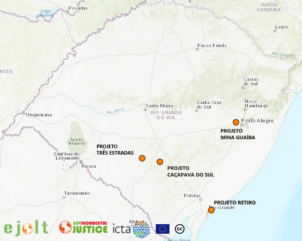
By Marcos Todt.
In Rio Grande do Sul alone there are more than 150 mining projects that may leverage Brazil’s new environmental code to their advantage.
Jair Bolsonaro’s victory in the 2018 Brazilian presidential election represented a new ultraconservative right-wing rise to power that radically dismantled environmental policies.
Brazil’s Minister of Environment has been previously convicted for illegally favouring mining companies.
In the southernmost state of Rio Grande do Sul alone, there are more than 150 mining projects that may leverage the new environmental code to their advantage.
Extreme
Justifications use corporate discourse promising jobs and revenue as well as arguing that current legislation stifles economy growth.
For example, Porto Alegre, a city famous for its history of direct democracy and for hosting the first sessions of the World Social Forum, is now threatened by the Guaíba Mine.
Besides that, three particularly extreme mining conflicts in Três Estradas, Caçapava do Sul, and Retiro are documented in the global Environmental Justice Atlas (EJatlas).
Brazilian private mining company Copelmi, with funding from the United States and China, is proposing Brazil’s largest open-pit coal mine only 9 miles away from downtown Porto Alegre and amid protected nature reserves.
Coal reserves are estimated to contain 166 million tons of ore over more than 4,300 hectares. Copelmi’s environmental impact analyses disregard the project’s proximity to the state capital’s centre.
Moreover, the proposed site is less than a mile from a river sourcing over 80 per cent of Porto Alegre’s water, with high risk of groundwater contamination by heavy metals.
Many families would be evicted, including farmers producing Latin America’s biggest rice yields. Amid humanity’s battle against climate change, corporations and the government prefer coal over safe rice.
“Pro-mining” Bolsonaro is supporting Australian company Aguia Resources Limited, associated with Canadian group Forbes & Manhattan, and its proposal for an open-pit phosphate mine and tailing dam in Lavras do Sul.
The site threatens the Pampa biome, which is 85 per cent grassland, because of degradation from pits, and huge tailings and sterile waste piles.
The region is home to more than 4,000 families and several indigenous peoples living on land reform settlements.
Recently, the National Human Rights Council recommended the annulment of the Preliminary License already granted to the project. Reasons include bribery and two university-conducted technical reports finding omissions and critical errors in the Environmental Impact Assessment (EIA).
The Pampas are also endangered by a copper, lead, and zinc mining project by the Camaquã River in Caçapava do Sul, considered one of the seven natural wonders of Rio Grande do Sul.
This project is proposed by Nexa Resources S/A, a company with headquarters in Luxembourg and shares traded in Toronto and New York formed in a merger between Votorantim Metais (Brazil) and Milpo (Peru).
Besides water contamination risks, agriculture and livestock may also be affected at farms preserving Brazilian heritage. There has already been a mercury leak in the early 1980s. Nearby cities in the same hydrographic basin are currently resisting the project.
In São José do Norte, Canadian-funded Rio Grande Mineração S/A has proposed ilmenite, rutile, and zirconite extraction in a region between Lagoa de Patos and the Atlantic Ocean that the Ministry of Environment has designated as highly vulnerable. Ilmenite is an ore for tintanium.
The project jeopardizes agriculture and artisanal fishing activities in the region. Locals strongly oppose the project and have filed legal cases to the Federal Public Ministry of Brazil exposing violations of the right to information and public participation in the environmental licensing process.
In 2019, the movement We Don’t Want Mining in São José do Norte drafted a law banning mining in the region. The City Council passed the law and it was sanctioned by the mayor, the population continues to mobilize against the company, which hasn’t given up on the project.
Mega-Mining Combat Committee
In response to possible social and environmental collapse in the region, in 2019 the Mega-Mining Combat Committee in Rio Grande do Sul (CCM/RS) was founded.
With the slogan, ‘Yes to life, no to destruction’, the initial goal was to raise awareness that the battle against mega-mining isn’t only environmentalist.
The CCM/RS successfully unified around 120 organizations, including environmental and social class associations, unions, groups of students and farmers, and research groups.
This mobilization empowered the movement and overcame political and hegemonic barriers marginalizing activism.
The CCM/RS has since been protesting, selling T-shirts, promoting and participating in debates, objecting the EIAs, among other mobilizing activities such as criticizing the hegemonic development model and addressing struggles concerning culture, territory, and place.
This Author
Marcos Todt is a social scientist and PhD student at Catholic University of Rio Grande do Sul (PUCRS) as well as a visiting researcher at the Institute of Environmental Science and Technology (ICTA-UAB). He is also a member of the Mega-Mining Combat Commitee in Rio Grande do Sul.
This article was first published at The Ecologist
It also appeared in Portuguese at Sul21

The project ENVJUSTICE has received funding from the European Research Council (ERC) under the European Union’s Horizon 2020 research and innovation programme (grant agreement No. 695446)